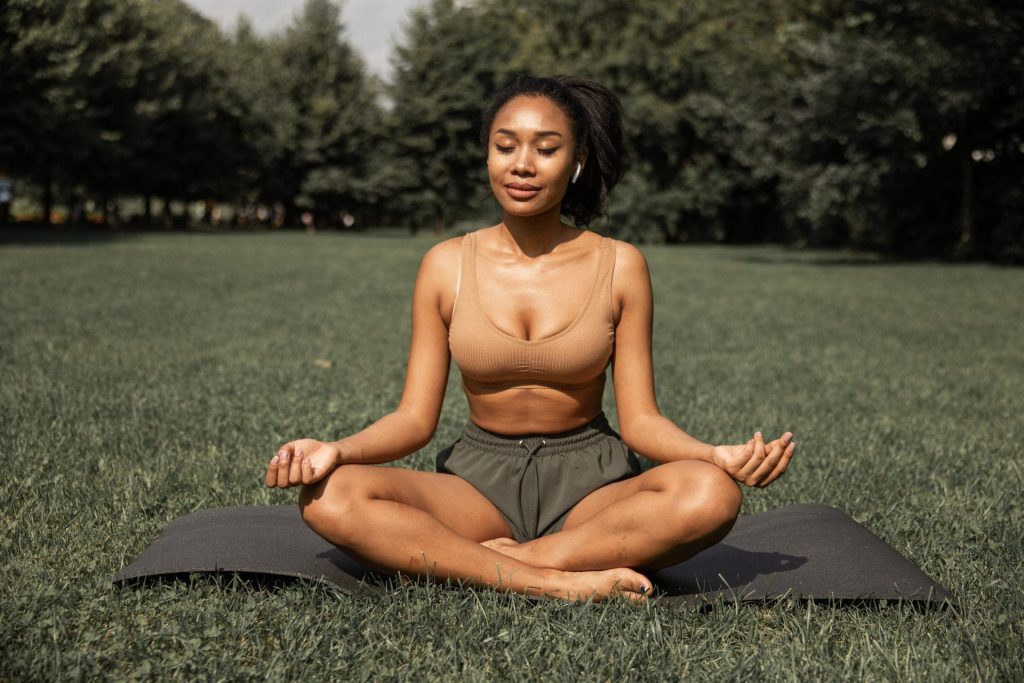Mastering mindfulness is entirely achievable as a solo endeavor especially if you practice it diligently, yet having a guiding teacher or following a structured program can prove invaluable, especially if you’re delving into meditation for targeted health benefits.
Are you on a conscious journey to mindfulness, in this article, we will be teaching you what mindfulness is and how you can practice it successfully.
So, How Do You Practice Mindfulness?
1. Comfortability Is Key

Begin your mindfulness meditation journey by selecting a calm and comfortable setting. This could be a designated meditation space, a cozy corner in your home, or even a peaceful spot in nature. Choose a chair or sit on the floor, and focus on maintaining a posture that keeps your head, neck, and back aligned – a position that’s both upright and relaxed. The idea is to find a balance between alertness and comfort, allowing you to remain attentive without unnecessary stiffness.
2. Savor Each Meal with Mindful Eating

It’s so easy to turn eating into a mechanical routine of bite, chew, and swallow, isn’t it? We’ve all had those moments when we finish a plate of food without really being present. However, eating is not just a task; it’s one of the most delightful experiences we partake in as humans. Engaging in mindful eating transforms this daily activity into a richer, more satisfying experience that goes beyond mere nutrition, addressing our subtler senses and needs.
When we direct our complete attention to our bodies and genuinely tune into our hunger, we unlock the potential to nourish not just our physical cravings but also our deeper, more nuanced desires. Always take a moment to breathe deeply before you start your meal. This simple act helps you transition from the hustle of the day to a more mindful state, allowing you to truly appreciate the food before you. Listen to your body, this helps you make choices aligned with its true needs and then eat according to your hunger.
3. Get Loose Beginning With Your Attire

Consider wearing loose, comfortable clothing to enhance your overall experience. This choice of attire supports the idea of minimizing potential distractions during your meditation session. Loose clothing allows for unrestricted movement and contributes to a sense of ease as you engage in the practice.
Also, one remarkable aspect of mindfulness meditation is its adaptability to various environments and time constraints. Unlike certain activities that come with a specific dress code, mindfulness meditation invites you to practice without such constraints. Whether you’re at home, in the office, or outdoors, there’s no need to adhere to a particular dress standard. This freedom emphasizes the accessibility and inclusivity of mindfulness, enabling you to integrate the practice seamlessly into your daily life, regardless of your attire. So, feel free to embrace this practice whenever and wherever unrestricted by wardrobe considerations.
4. Set a Timer for Mindful Moments

Think about incorporating a timer into your meditation routine. It’s not a must-have, but having one, preferably with a soft, gentle alarm, can work wonders. Why? It helps you immerse in meditation without constantly checking the clock and prevents any easy excuses to cut your session short.
The timer serves a dual purpose. Firstly, it aids in maintaining focus by allowing you to forget about time constraints. Secondly, it acts as a gentle reminder, ensuring you don’t unintentionally extend your meditation into the realms of time overindulgence. Post-meditation, allocate a few moments to reorient yourself to the present before rising gradually.
Many find that time tends to slip away during meditation, so having a timer not only helps with discipline but also ensures your practice remains within a comfortable timeframe. If you’re just starting, kick off with a brief 5-minute session. As you grow more at ease, gradually extend your meditation by 10 or 15 minutes until you find yourself comfortably settled into 30-minute sessions. Remember, consistency matters more than duration, so even a few minutes of daily meditation can yield positive results.
5. Concentrate On Your Breathe

Immersing yourself in the practice of mindfulness meditation begins with a simple yet profound act: directing your attention to your breath. This foundational technique serves as a gateway to a more centered and present state of being.
Start by finding a comfortable position, whether sitting or lying down and bring your awareness to the breath. Feel the subtle, rhythmic movement as the air effortlessly enters and exits your body. Pay special attention to the rise and fall of your belly, a natural indicator of your breath’s ebb and flow.
As you inhale, notice the refreshing coolness as the air enters your nostrils. Conversely, with each exhale, sense the warmth that accompanies the breath’s departure. This heightened awareness of the sensory experience of breathing anchors you firmly in the present moment.
Amid our busy lives, where distractions abound, this act of focusing on the breath becomes a sanctuary. It is a gentle reminder to be fully present, to let go of the past and future momentarily, and to embrace the richness of the now.
6. Become Mindful Of Your Thoughts

In the realm of mindfulness, the aim isn’t to halt the flow of your thoughts but rather to become at ease with the role of a “witness” to them. When thoughts naturally arise, there’s no need to dismiss or push them away. Instead, observe them with a calm demeanor, using your breath as a steady anchor.
Picture your thoughts as clouds drifting across the sky of your mind. Allow them to appear and disappear, shifting and changing like the ever-moving clouds. In this process, you’re not attempting to suppress or control your thoughts; rather, you’re cultivating a mindful awareness, gently observing the ebb and flow of your mental landscape.
As you meditate, repeat this practice whenever necessary. It’s a gentle reminder that, much like clouds passing through the vast sky, thoughts come and go. By adopting this approach, you not only prevent the struggle against your thoughts but also foster a sense of tranquility as you navigate the currents of your mind.
7. You Deserve A Break

While practicing this, if you catch yourself being swept away by a cascade of thoughts—be it worry, fear, anxiety, or even hope—take a moment to observe where your mind has wandered. No need for self-judgment; instead, gently guide your focus back to your breath. It’s okay if this happens; in fact, the very act of redirecting your attention to the present moment is the essence of practicing mindfulness.
So, be kind to yourself, embrace the process, and remember that the practice lies in the return to your breath and the gentle refocusing on the here and now.
8. Use A Mindfulness App

If practicing mindfulness meditation solo alone feels challenging, why not explore the world of mindfulness apps? Platforms like Calm or Headspace offer a treasure trove of free guided meditations and a toolkit of techniques to anchor you in the present throughout your day. These apps can be your companions on the journey to a more centered and mindful existence.
Conclusion
In Summary, embarking on a personal journey of mindfulness involves creating a comfortable meditation space, practicing mindful eating, and incorporating loose, comfortable clothing. The adaptability of mindfulness to various settings frees individuals from dress code constraints. Integrating a timer fosters discipline in meditation sessions.
The core practice involves directing attention to the breath, cultivating mindful awareness of thoughts as drifting clouds, and returning focus to the present moment when thoughts wander. Mindfulness apps like Calm or Headspace provide guided meditations and tools for those seeking additional support on their journey. Ultimately, the goal is self-discovery, tranquility, and a deepened connection with the richness of each unfolding moment.
